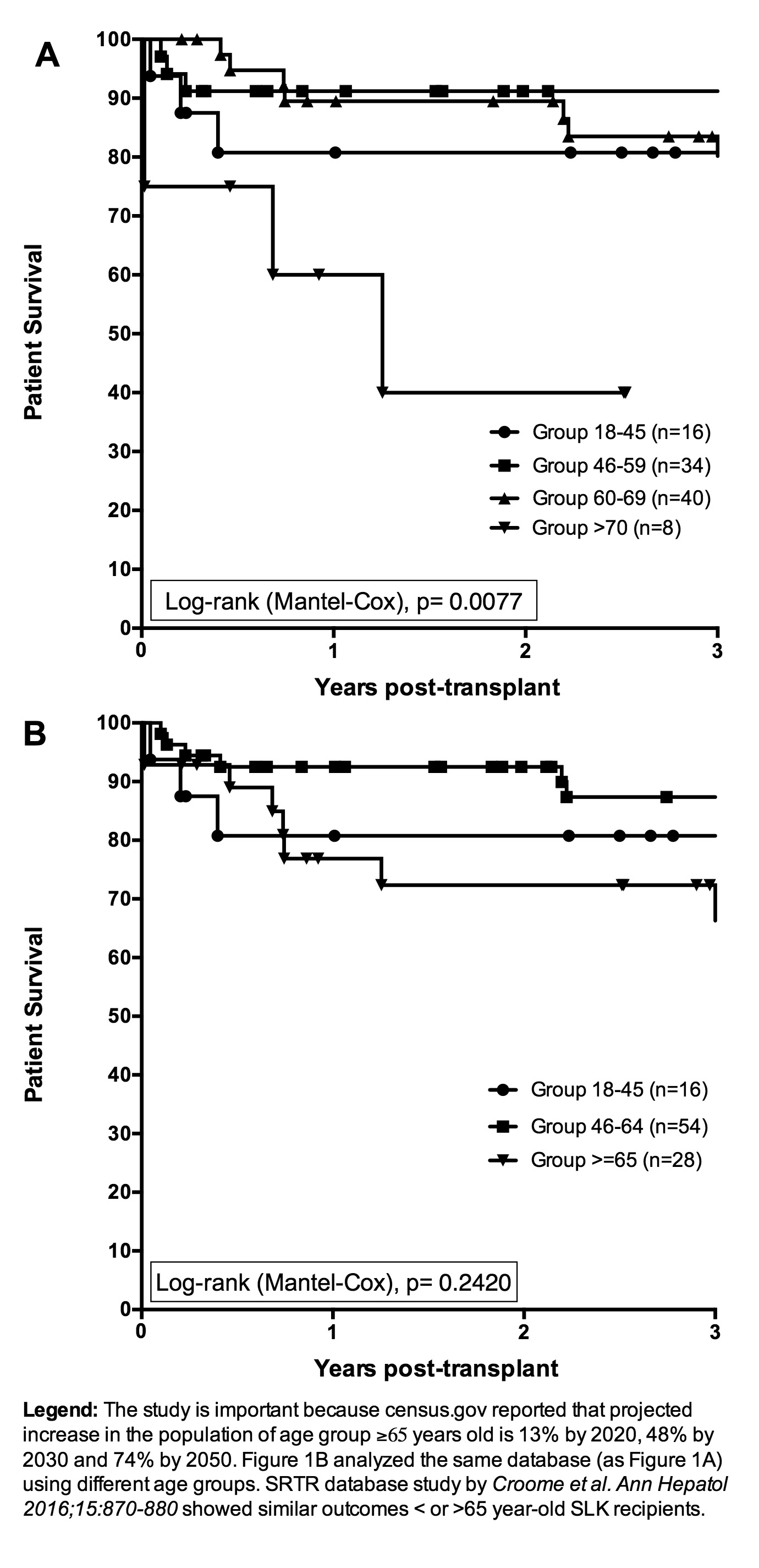Impact of Recipient Age in Combined Liver-Kidney Transplantation (CLKT): Caution is Needed for Elderly Patients≥70 Years
1Transplant Division, Department of Surgery, Indiana University, Indianapolis, IN, 2Gastroenterology, Indiana University, Indianapolis, IN
Meeting: 2019 American Transplant Congress
Abstract number: 566
Keywords: Liver transplantation, Outcome
Session Information
Session Name: Concurrent Session: Liver: Recipient Selection
Session Type: Concurrent Session
Date: Tuesday, June 4, 2019
Session Time: 4:30pm-6:00pm
 Presentation Time: 4:54pm-5:06pm
Presentation Time: 4:54pm-5:06pm
Location: Room 312
*Purpose: Recent SRTR analysis showed that elderly recipients (≥70 years) accounts for 2.6% of all liver transplant alone (LTA) and do as well as younger LTA recipients, if selected carefully. Although the rate for elderly recipients in CLKT is similar (2%, 104/5194), no national or center-based data is available how elderly recipients perform after CLKT. The purpose of this study is to identify whether CLKT is safe in elderly recipients.
*Methods: After we showed excellent outcomes in CLKT using delayed KT (Indiana) Approach, we now routinely delay the kidney portion of CLKT (mean kidney CIT 53±14hours, range 20-83). Between 2007-2018, 98 CLKT were performed using the Indiana Approach. The rationale behind performing delayed KT was to offer less hostile environment with hemodynamically more stable LT recipient at the time of KT. Recipients were subgrouped based on their age, such as 18-45 (n=16), 46-59 (n=34), 60-69 (n=40), and ≥70 years (n=8). 45 different variables were compared.
*Results: Overall more elderly patients receive LTA at Indiana University (IU) compared to SRTR (recipients ≥70 years; 5.2% at IU vs. 2.6% SRTR). The rate of elderly recipients in CLKT at IU was 8.2% (vs. 2% SRTR). In the present study, recipient and donor characteristics were comparable between all age groups, except recipient age as expected (p<0.01). Although patient survival at 1-year (80%, 88%, 92%) and 3-year (80%, 83%, 92%) was similar in age groups 18-45, 46-59, and 60-69, respectively, it was significantly lower in recipients≥70 years at 1-year (60%) and 3-year (40%) (Figure 1A). Recent SRTR data which compared recipient age < and >65 years in CLKT showed similar outcomes. To replicate the SRTR survival stratification, we ran an analysis using 18-45, 46-64, and ≥65 years age groups, as controls (Figure 1B). Control analysis showed that patient survival was similar among different age groups, as shown by the SRTR analysis.
*Conclusions: Although LTA can be safely performed in selected elderly recipients, extreme caution is needed in recipients ≥70 years undergoing CLKT due to the magnitude of operation and expected poor outcomes.
To cite this abstract in AMA style:
Ekser B, Goggins WC, Mangus RS, Mihaylov P, Fridell JA, Lacerda MA, Ghabril MS, Powelson JA, Kubal CA. Impact of Recipient Age in Combined Liver-Kidney Transplantation (CLKT): Caution is Needed for Elderly Patients≥70 Years [abstract]. Am J Transplant. 2019; 19 (suppl 3). https://atcmeetingabstracts.com/abstract/impact-of-recipient-age-in-combined-liver-kidney-transplantation-clkt-caution-is-needed-for-elderly-patients%e2%89%a570-years/. Accessed December 22, 2025.« Back to 2019 American Transplant Congress

